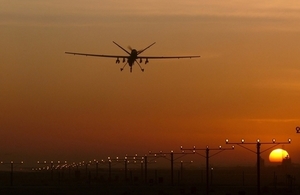Communications from high-altitude unmanned air systems
Case study from Roke Manor Research Ltd who pitched their ideas to industry and investors at the CDE Marketplace on 27 April 2016.

A Reaper Remotely Piloted Air System (RPAS) comes into land at Kandahar Airbase in Helmand, Afghanistan.
Roke has been funded by the Centre for Defence Enterprise (CDE) for a project to allow communications from a high-altitude unmanned air system (UAS) to be transmitted via a standard 4G data-card from the UAS to commercial base stations.
Due to the extreme height of high altitude, long endurance (HALE) aircraft this concept wouldn’t normally work. Commercial base station antenna beams point horizontally, rather than being directed skywards, to give maximum coverage to ground-based phone users.
Roke’s demonstrator system will demonstrate the principle of automatic base station location and beamforming. While an applique coupled to a standard 4G phone will enable the system to connect to base stations much further away than normal.
This capability could be used for HALE aircraft or those with very low size, weight and power requirements.
Roke, based near Romsey, was founded in 1956 and currently employs around 350 people. The company provides research, development and consultancy services in cyber, communications, information systems and electronic sensors across the defence, security and commercial domains.
View the pitch presentation slides.
About CDE
CDE funds novel, high-risk, high-potential-benefit research. We work with the broadest possible range of science and technology providers, including academia and small companies, to develop cost-effective capabilities for UK armed forces and national security.
CDE is part of Dstl.
Centre for Defence Enterprise
Building R103
Fermi Avenue
Harwell Oxford
Oxfordshire
OX11 0QX
Please email for the quickest response.